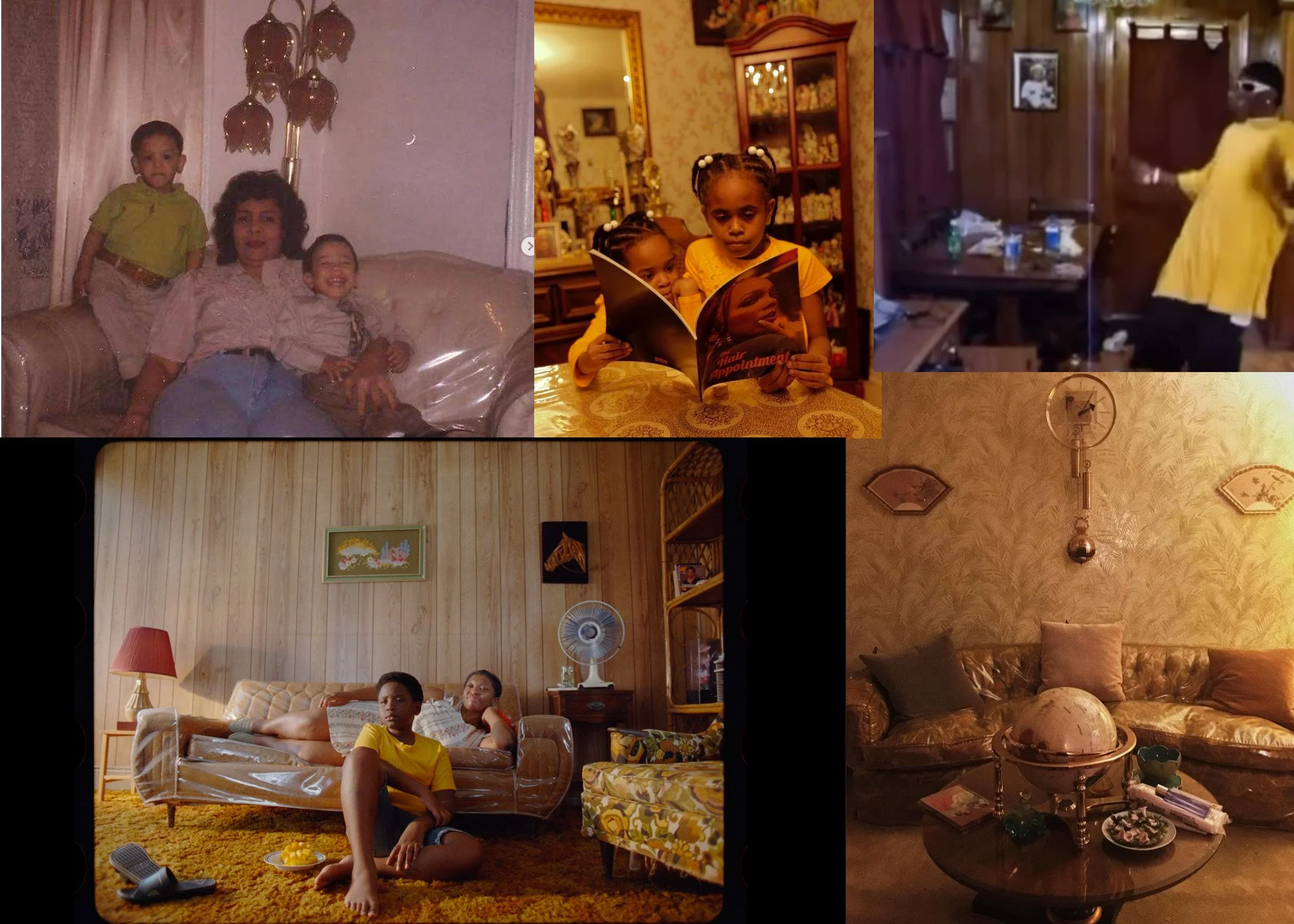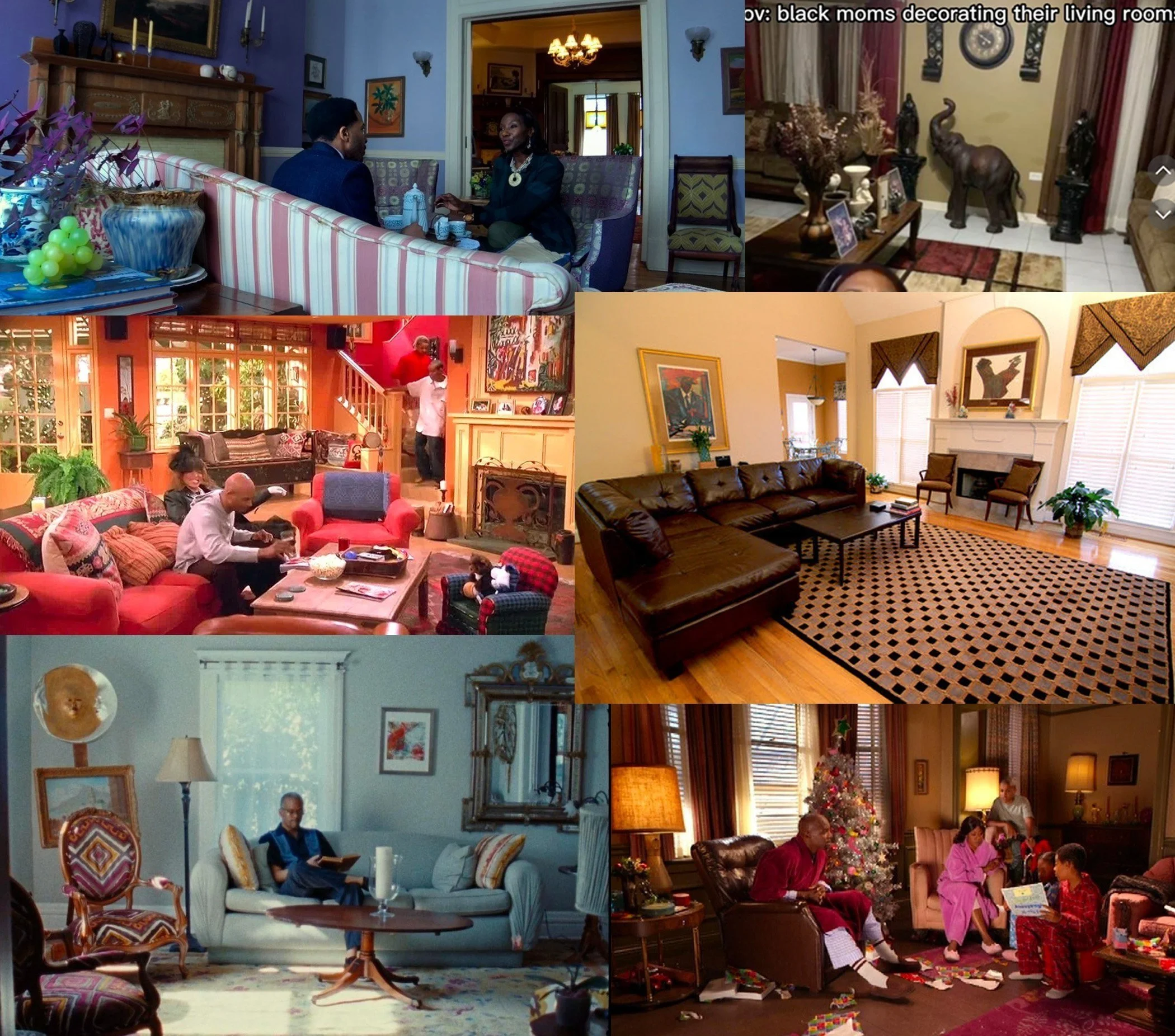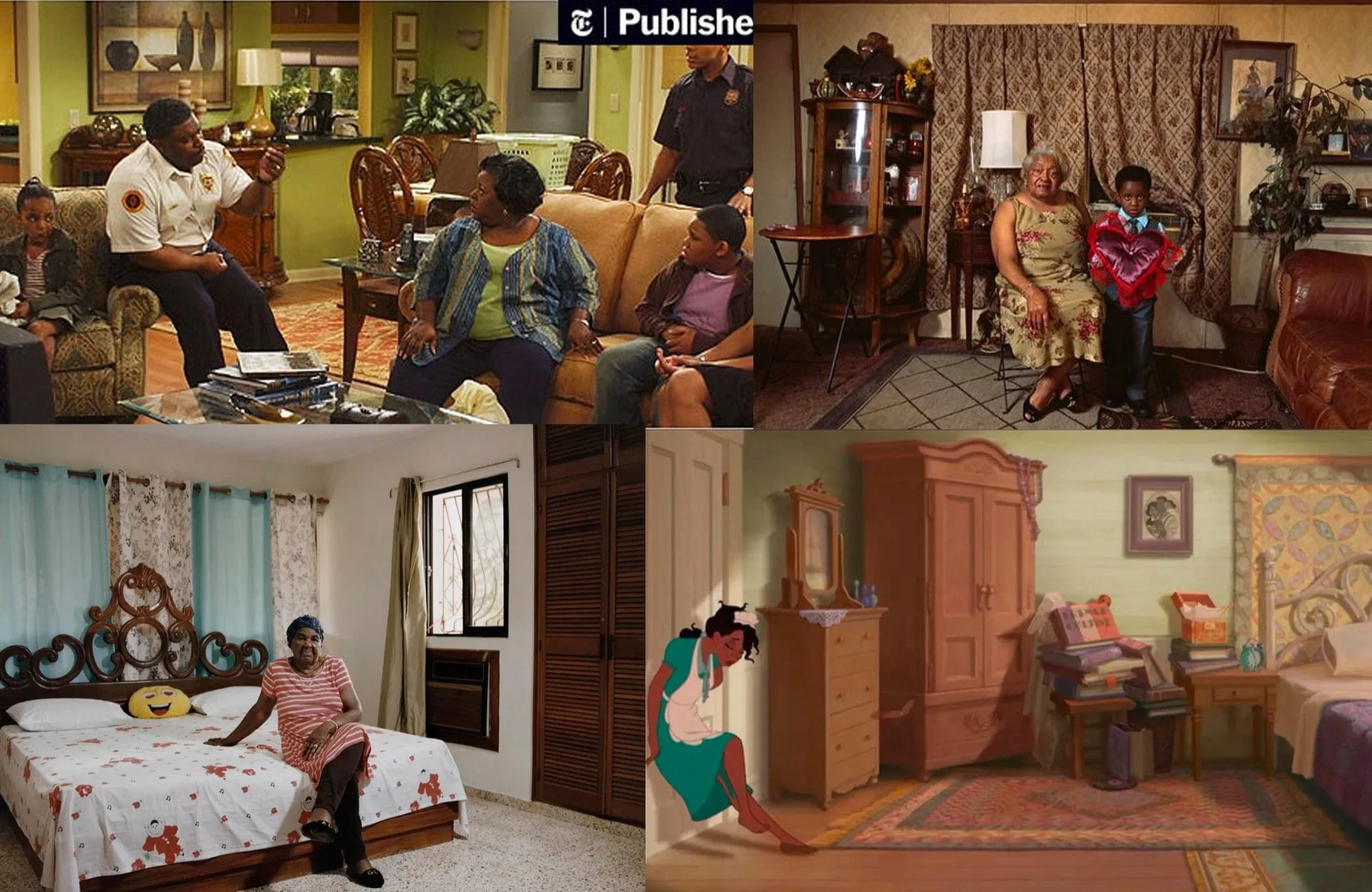Research
“...A‘black aesthetic’ is the name for a collection of philosophical theories about the arts of the African diaspora: an aesthetic grounded in the idea of a new, that is, a post-Emancipation and post colonial, black identity which, from Jazz Age Harlem and Montparnasse, to the ‘sound system’ societies of west Kingston, south London, and south central Los Angeles, thrives in black communities where artistic creativity and performance are the basic cultural currencies.” (Richard J. Powell)
Quantifying the Black aesthetic in any category of research can be a complicated task. The term requires careful consideration. While attempting to construct a visual typology through mass media research, I found clarifying the meaning of this sentiment necessary. There is beauty in an undefined Black aesthetic, as there is no singular way qualify a definitive set of characteristics for peoples who have merged from clusters of west, central, and east African cultures. In analyzing a culture that has subsets of values and understandings which vary both domestically and globally, it is important to question and evaluate the attributes that are broadcasted in mainstream media- as well as how these representations may be perceived by those within and outside of said Black culture.
What is this 'Black' in Black Popular Culture? (1992), by Stuart Hall, works to define Black popular culture as a distinctive mark of difference within contradictory forms of popular culture by acknowledging the ideological pitfalls of categorical absolutes and recognizing the reality, veracity, and strategic necessity of such a concept. The term “Black” constitutes the Black community.
Blackness is aesthetic.
Blackness is composed of distinct cultural repertoires shaping popular representations.
However, Blackness- from unfamiliar perspectives- is defined by difference.
As a people, we connect and create through overarching relatability and tradition. Still, there is a complicated case of cultural hybridity occurring. The media is a crucial factor in creating spatialized blackness- which accounts for the ways in which different landscapes impact Black mobility through geographies of confinement and surveillance.
When analyzing various forms of media, including television, film, music videos, and social media, I found a complex interaction between visual and cultural elements within Black homes- which reflect a harmonization of ancestral knowledge and contemporary expressions. Hues of black, brown, green and red; objects, like doilies, quilts, and plastic on upholstered furniture are performance. These facets of Black life all transcend into Black legacies and futures, playing a major role in cultural continuity pertinent to the existence of Black people. The Black aesthetic is not a mere stylistic choice. It’s an intentional tool for resistance, whether through action, or physical objects in the home. A trend I noticed in my archival investigation was the large quantity of staged sets that are created as representations of the Black characters- which often borrow a strong sense of the 1970s American interior. A heavy use of wood, paneling, patterned upholstery, patterned wallpaper, knick knacks- and more- are very reminiscent of past eras.
Whilst reviewing cultivation theory, I began to wonder why designers and media outlets have continuously utilized these visual details to represent Black families. It is important to note that in the mid-20th century, there was an emergence of a middle class livelihood for African Americans. This is due to the major changes that were made during the Civil Rights movement; and the new freed generations that were able to make strides in academics and employment. At the same time, Caribbean Immigration in the United States increased, creating cultural immersion that this country had never seen before.
Media cultivates visual narratives. The stylings and visual attributes of this era resulted in the cementing of a Black media aesthetic- which has become the generalized view of Black and Caribbean culture by way of interior.
*See: The Jeffersons, Everybody Hates Chris, Good Times, My Wife and Kids, etc.
In cultivation theory, researchers argue that television has long-term attitudinal effects which are small- yet gradual, and inadvertently direct. These effects still carry cumulative and significant impacts on the population. Media shapes our perception of the Black aesthetic, and suggests a nuanced combination of cultures and identities, embodying a cemented tapestry of community tradition. It’s possible that these traditional Black home-space aesthetics could have developed out of reality. However, the intertwining of media portrayal and cultural identity signify the profound impact of representation on societal attitudes and the formation of collective memory within Black communities; highlighting the intricate relationship between media consumption, identity formation, and the perpetuation of cultural traditions.
The themes of Black diasporic domesticity revolve around performance, autonomy and safety. The built environment shapes the movement of racialized bodies in the same way that these bodies shape their surroundings. Due to the racialization of space and the lack of ownership, the domestic home has become a place that represents freedom, confidence and autonomy of oneself and identity. The construction of a homeplace, no matter its fragility, has a radical and political dimension, acting as a site of resistance.
The idea of resistance through existence prompted me to comprehend the presumed aesthetic as a series of hauntings. “... haunting points to the non-full, non-total presence of being. In every being there’s always already an absence of presence, an inheritance, a trace of that which was and that which is to come. In every being there is a haunting. Haunting is a necessity of recursivity. As a process, finite models seek to compress infinite information, including that which is indeterminate to the model’s system – it is the indeterminacy of being that drives us to escape or complete our sense of being. It is this indeterminacy that capitalism seeks to fill with objects and identification.” (Ezekiel Dixon-Ramon)
Framing my analysis around this concept creates the proper foundation for looking at items like doilies and color palettes as something beyond a simple aesthetic choice, but instead, physical objects layered with history. Because hauntings are referencing the past, they reinforce the idea that the Black aesthetic is an ever changing and evolving form.
I find myself at the intersection of these varying aesthetics. As a third generation Dominican, I have a nuanced perspective on the complexities of the evolution of these interiors.
Aventura, a group based in New York City- is championed for their clever Americanization of the infamous Bachata genre. They are the first Bachata group to incorporate English, Hip Hop, and R&B elements this style of music. Their lyricism and composition is rooted their first generation heritage as Dominican artists. They created music with strong African influences under the themes of nostalgia, yearning, remembrance, love, and betrayal. These themes are contingent with those that I relate to Black domestic interiors, and for that reason, I chose represent this juxtaposition of artifacts present across identities within globalized Black culture, and music with similar histories of melancholic themes.
Media is extremely critical to the Black and Caribbean diasporic identity. Cultivation theory is essential to the development of cultural aesthetics. Gods Project was Aventuras fourth studio album; the title inspired by their belief that God graced them with success. This album is representative of numerous ethnoracial elements. It was a cultural shift in hispanic identity. It’s existence is an example of the official commercialization of “developed” Bachata, Neo-Soul, and marked the presence of a growing audience of Latinos who identify with the standardized American lifestyle. Pride and faith are strong themes in my understanding of Black and Caribbean domestic spaces- and imperative in this body of music.
The rendered set focuses on 3 songs: “La Boda '', “Angelito” and “Un Beso.” Incorporated into these sets are the objects of haunting on all scales- with a direct nod to the vitrina, wooden antiques, plastic sofas, prevalent textures and finishes, physical movements, and most importantly, lyrical symbolism. Set on a beach, the camera follows a couple in one of their childhood apartments- experiencing the woes and emotions of human intimacy.
My comprehensive exploration of the Black interior design aesthetic in mass media representation led me to an expanded understanding of identity, tradition, and resistance. Through my production of this imagery, I was able to research the complexities of the Black identity through the diaspora. The entwined cultural repertoires, counter-narratives, and mainstream representations that became clear in this final product exposed the multifaceted nature of Black visual culture. The architectural theories that I researched, and referenced in this exploration opened up concepts revolving around spatialized blackness, which reinforced the physical environment’s impact on the Black individual’s sense of aesthetic, mobility, and belonging. The act of collecting imagery with this theory in mind allowed me to uncover an array of ancestral knowledge, tradition, and contemporary expression critical to Black domestic spaces.
This concept transcends mere stylistic choice, serving as a deliberate form of resistance against historical injustice and ongoing societal hardship.
By drawing connections between the themes in Aventura's music, and the symbolic elements present in Black domestic spaces, this exploratory project showcases the fusion of traditional and contemporary aesthetics rooted in deep introspective ideology and global history.
This study is an effort to ensure that these visual cultures are remembered eternally. The aesthetic that is present in my renderings is a dying one- built on the generational practices of marginalized populations.
Though so familiar to many, these elements are undocumented, unquantified, and unacknowledged. Therefore, these visuals deepen our understanding of the Black and Caribbean aesthetic- while simultaneously emphasizing the cultures’ endurance, relevance, and significance in contemporary discourse.



